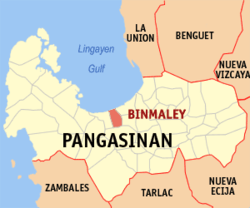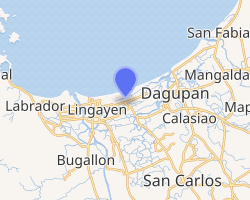Binmaley, Pangasinan
Binmaley, officially the Municipality of Binmaley (Pangasinan: Baley na Binmaley; Ilocano: Ili ti Binmaley; Tagalog: Bayan ng Binmaley), is a 1st class municipality in the province of Pangasinan, Philippines. According to the 2015 census, it has a population of 83,052 people.[3]
Binmaley | |
|---|---|
| Municipality of Binmaley | |
 Seal | |
 Map of Pangasinan with Binmaley highlighted | |
OpenStreetMap 
| |
.svg.png) Binmaley Location within the Philippines | |
| Coordinates: 16°01′56″N 120°16′09″E | |
| Country | |
| Region | Ilocos Region (Region I) |
| Province | Pangasinan |
| District | 2nd district |
| Founded | February 1, 1590 |
| Barangays | 33 (see Barangays) |
| Government | |
| • Type | Sangguniang Bayan |
| • Mayor | Simplicio D. Rosario |
| • Vice Mayor | Edgar C. Mamenta |
| • Congressman | Jumel Anthony I. Espino |
| • Electorate | 60,870 voters (2019) |
| Area | |
| • Total | 118.50 km2 (45.75 sq mi) |
| Population (2015 census)[3] | |
| • Total | 83,052 |
| • Density | 700/km2 (1,800/sq mi) |
| • Households | 18,204 |
| Economy | |
| • Income class | 1st municipal income class |
| • Poverty incidence | 9.21% (2015)[4] |
| • Revenue (₱) | 160,401,850.71 (2016) |
| Time zone | UTC+8 (PST) |
| ZIP code | 2417 |
| PSGC | |
| IDD : area code | +63 (0)75 |
| Climate type | tropical monsoon climate |
| Native languages | Pangasinan Ilocano Tagalog |
Binmaley is located along the western coastland of Pangasinan facing the Lingayen Gulf, in between Lingayen and Dagupan City. On January 8–9, 1945, the amphibious forces of U.S. General Douglas MacArthur used the town's beach, designated as "yellow beach", alongside the beaches of Lingayen, Dagupan, and San Fabian, in their landing operations to liberate Luzon from Japanese occupation during World War II.
The town is famous for its bangus (milkfish) aqua-culture, due to the existence of its numerous fishponds (pokok in the Pangasinan language). However, because of constant siltation over the past several years from mine tailings upstream from Agno River (due to mine operations in neighboring Benguet Province), and the overuse of artificial fish feeds, the bangus industry has suffered from fishkill, fewer viable fishponds and lower harvests. As a result, many formerly productive fishponds have been converted into large commercial and residential lots. This phenomenon is beginning to seriously threaten the unique Binmaley fishpond industry. Current Government action is inadequate due to strong pressures from other competing commercial interests, not to mention fishfeed producers.
Binmaley's town center has a Neo classical church dating back to the 17th century. It also became famous throughout the Philippines for the outstanding academic achievements of students (and its distinctive corps of military cadets) from its Binmaley Catholic High School, especially when it was headed by a German priest, Fr. Leo Behneke, in the 1960s and 1970s. Its name roughly means "the place which became a town" or "went to town" in the Pangasinan language.
Binmaley, is famously known for its "Sigay Festival". The Pangasinan word sigay broadly translates to harvest, or a time to gather the rich yields of the farm, the sea, the ponds and the rivers. It also relates to a contraction of the words silew, meaning light, and gayaga, meaning merriment. It was Mayor Lorenzo "Enzo" Cerezo who pioneered and founded "Sigay Festival".
Barangays
Binmaley is politically subdivided into 33 barangays.
- Amancoro
- Balagan
- Balogo
- Basing
- Baybay Lopez
- Baybay Polong
- Biec
- Buenlag
- Calit
- Caloocan Dupo
- Caloocan Norte
- Caloocan Sur
- Camaley
- Canaoalan
- Dulag
- Gayaman
- Linoc
- Lomboy
- Nagpalangan
- Malindong
- Manat
- Naguilayan
- Pallas
- Papagueyan
- Parayao
- Poblacion
- Pototan
- Sabangan
- Salapingao
- San Isidro Norte
- San Isidro Sur
- Santa Rosa
- Tombor
Demographics
|
| ||||||||||||||||||||||||||||||||||||||||||||||||
| Source: Philippine Statistics Authority[3][5][6][7] | |||||||||||||||||||||||||||||||||||||||||||||||||
Climate
| Climate data for Binmaley, Pangasinan | |||||||||||||
|---|---|---|---|---|---|---|---|---|---|---|---|---|---|
| Month | Jan | Feb | Mar | Apr | May | Jun | Jul | Aug | Sep | Oct | Nov | Dec | Year |
| Average high °C (°F) | 31 (88) |
31 (88) |
33 (91) |
34 (93) |
34 (93) |
33 (91) |
32 (90) |
31 (88) |
31 (88) |
32 (90) |
31 (88) |
31 (88) |
32 (90) |
| Average low °C (°F) | 21 (70) |
21 (70) |
23 (73) |
25 (77) |
25 (77) |
25 (77) |
25 (77) |
24 (75) |
24 (75) |
24 (75) |
23 (73) |
22 (72) |
24 (74) |
| Average precipitation mm (inches) | 4.3 (0.17) |
19.1 (0.75) |
27.3 (1.07) |
45.2 (1.78) |
153.3 (6.04) |
271.3 (10.68) |
411.1 (16.19) |
532 (20.9) |
364.4 (14.35) |
182.5 (7.19) |
56.3 (2.22) |
24.4 (0.96) |
2,091.2 (82.3) |
| Average rainy days | 3 | 2 | 3 | 5 | 14 | 17 | 22 | 23 | 21 | 13 | 7 | 4 | 134 |
| Source: World Weather Online[8] | |||||||||||||
Heritage
Images
- The Our Lady of the Purification Parish Church
- Binmaley Museum
- Bulwagan ng Sangguniang Bayan at Himpilan ng Pambansang Kapulisan
- Pamilihang Bayan ng Binmaley
- Manat river & Gumapos Bridge
References
- "Municipality". Quezon City, Philippines: Department of the Interior and Local Government. Retrieved 31 May 2013.
- "Province: Pangasinan". PSGC Interactive. Quezon City, Philippines: Philippine Statistics Authority. Retrieved 12 November 2016.
- Census of Population (2015). "Region I (Ilocos Region)". Total Population by Province, City, Municipality and Barangay. PSA. Retrieved 20 June 2016.
- "PSA releases the 2015 Municipal and City Level Poverty Estimates". Quezon City, Philippines. Retrieved 1 January 2020.
- Census of Population and Housing (2010). "Region I (Ilocos Region)". Total Population by Province, City, Municipality and Barangay. NSO. Retrieved 29 June 2016.
- Censuses of Population (1903–2007). "Region I (Ilocos Region)". Table 1. Population Enumerated in Various Censuses by Province/Highly Urbanized City: 1903 to 2007. NSO.
- "Province of Pangasinan". Municipality Population Data. Local Water Utilities Administration Research Division. Retrieved 17 December 2016.
- "Binmaley, Pangasinan: Average Temperatures and Rainfall". World Weather Online. Retrieved 26 September 2015.
External links
| Wikimedia Commons has media related to Binmaley. |